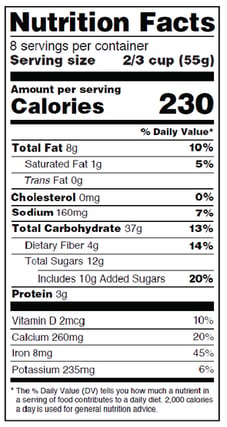 In January I wrote about the confusing world of sugar and how it would get a lot less confusing when the FDA passed new changes to the food label that would make added sugar more prominent. On May 20, 2016, they finalized the new Nutrition Facts Label for consumers, and by July 26, 2018, all labels are required to show these changes.
In January I wrote about the confusing world of sugar and how it would get a lot less confusing when the FDA passed new changes to the food label that would make added sugar more prominent. On May 20, 2016, they finalized the new Nutrition Facts Label for consumers, and by July 26, 2018, all labels are required to show these changes.
The New Nutrition Facts Labels
So, how can the new food label help when you are at the grocery store? These are the major changes that will begin appearing on all labels.
- The type size for “Calories,” “servings per container,” and “Serving size” will be increased and the number of calories and “Serving size” will be boldfaced.
- Manufacturers must add the gram weight of Vitamin D, Calcium, Iron, and Potassium.

- The footnote will be worded differently to help consumers understand its meaning. It will read: “The % Daily Value tells you how much a nutrient in a serving of food contributes to a daily diet. 2,000 calories a day is used for general nutrition advice.”
- “Added sugars” in grams and a percentage of the daily value will be added to the label.
- Calories from fat is being removed because research shows that the type of fat in your diet is more important than the total amount.
- Serving sizes are changing based on what people are actually eating and not what they should be eating. Since the portion sizes have changed since 1993 when labels were first introduced, this will be reflected by soda increasing from an 8-ounce portion size to 12 ounces on the new label.
- On packages that are between 1 and 2 servings, such as a 20-ounce soda or a 15-ounce can of soup, the label will reflect one serving since that is typically what people consume in one sitting.
If you have any questions about the new labeling changes or would like to schedule a personal nutrition coaching session, please contact Angie Mitchell at ascheetz@nifs.org.
This blog was written by Angie Mitchell, RD, Wellness Coordinator. To find out more about the NIFS bloggers, click here.

